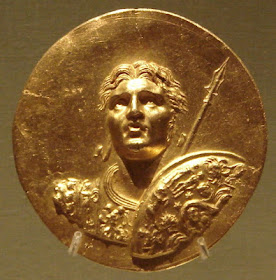Oceanus is one of the Titans, eldest son of Ouranos and Gaia. He is married to His sister, Tethys. From their union came the ocean Nymphs, known as the 3,000 Oceanids. The river Gods are His children as well.This is the God of the backward-flowing river Ocean, which bounds the earth and from which all rivers flow and every sea, and all the springs and wells.
When the Titans overthrew their father Ouranos, and Cronos castrated Him , Oceanus did not participate in the rebellion. He also kept His distance from His siblings during the Titanomachy. In fact, His wife Tethys nursed and protected Hera in Their palace, during the Titanomachy. In the Iliad, Hera mentions that She is going to visit Her foster parents:
'For I am faring to visit the limits of the all-nurturing earth,
and Oceanus, from whom the gods are sprung, and mother Tethys,
even them that lovingly nursed and cherished me in their halls,
when they had taken me from Rhea...'
We also see Oceanus showing his compassion for Prometheus, and went to see him when he was chained in Caucasus. He generally seems to keep a distance from the affairs of the Gods as He as he does not—and unlike all the other river Gods, His sons—take part in the convention of Gods on Mount Olympus.
At first, Oceanus ruled over the Mediterranean and the Indian Ocean. Later, when the Greeks learned of the Atlantic Ocean and other bodies of salt water his role expanded. When the Olympians took over, Poseidon became the ruler of the Mediterranean Sea.
In Hellenistic and Roman mosaics, this Titan was often depicted as having the upper body of a muscular man with a long beard and horns (often represented as the claws of a crab) and the lower body of a serpent. On a fragmentary archaic vessel of circa 580 BCE, among the Gods arriving at the wedding of Peleus and the sea-nymph Thetis, we see a fish-tailed Oceanus, with a fish in one hand and a serpent in the other; gifts of bounty and prophecy.
According to Homer, Oceanus is the ocean-stream at the margin of the habitable world, the father of everything, limiting it from the underworld and flowing around the Elysium.
Oceanus is also mentioned in the Odyssey, as Circe instructs Odysseus on how to reach the Underworld.
"… when in your ship you have now crossed the stream of Oceanus, where is a level shore and the groves of Persephone…beach your boat there by Ocean's swirling streams and march on into Hades' dark house."

























































